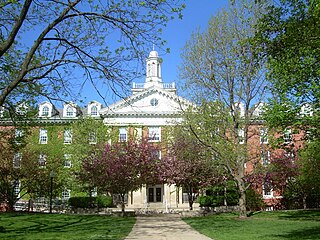Related Research Articles

The University of Delaware Botanic Gardens are botanical gardens and an arboretum located on the campus of the University of Delaware, in Newark, Delaware, United States. The gardens are open to the public without charge.

The Donald E. Davis Arboretum, in Auburn, Alabama, United States, is a public native plants museum, and botanical arboretum with educational facilities, event spaces, and a conservation program. Its grounds, covering 13.5 acres of Auburn University's campus, include cataloged living collections of associated tree and plant communities representative of Alabama's ecosystems, among which is mixed oak forest, carnivorous bog, and longleaf pine savanna. The living collections include more than 1,000 plant types, including 500 different plant species, with over 3,000 cataloged specimens. The Arboretum contains over a mile (2 km) of interwoven walking trails that meander through various southeastern biotopes.
The Alice Abel Arboretum is a 25 acres arboretum located at 5000 St. Paul Street on the campus of Nebraska Wesleyan University in Lincoln, Nebraska.
The Idaho State Arboretum is an arboretum located across the campus of the Idaho State University, Pocatello, Idaho, United States. It is open to the public daily without charge and includes an organized tree walk.

The Fell Arboretum is an arboretum located across the campus of Illinois State University in Normal, Illinois.

Peavy Arboretum is an arboretum operated by Oregon State University and located on Arboretum Road, Corvallis, Oregon. It is open to the public daily without charge.

Panonychus ulmi, the European red mite, is a species of mite which is a major agricultural pest of fruit trees. It has a high reproductive rate, a short generation time and produces many broods in a year, all of which contribute to its pest status. It has a cosmopolitan distribution, and a very wide host range, having been found on the following plants:
The Giardino Botanico della Scuola Media Statale "E.Toti" di Musile di Piave is an arboretum and botanical garden located on the grounds of the middle school "E. Toti", Via Guglielmo Marconi, Musile di Piave, Province of Venice, Veneto, Italy. It is open daily.
The Arboretum d'Amance is an arboretum located in Champenoux, Meurthe-et-Moselle, Lorraine, France. It is managed by the Centre INRA de Nancy, a branch of the Institut National de la Recherche Agronomique (INRA), and open on the third Saturday of the warmer months; an admission fee is charged.

The Arboretum La Alfaguara was formerly a tree nursery in the Sierra de la Alfaguara, in Alfacar near Granada in Spain. It contains samples of many of the trees that are scattered throughout the Sierra and the surrounding mountain ranges.
This is an alphabetical list of useful timber trees, indigenous and exotic, growing in the Gauteng area of South Africa. These trees range in size up to some 1.5m DBH, such as Cedrus deodara, the Himalayan Cedar. Hobbyists will seek out even small pieces of highly valued timber, such as Buxus macowanii, the South African counterpart of Buxus sempervirens, for turnery or the making of boxes and small items. Despite the wealth of useful woods available in Gauteng, most of the trees, felled or fallen, are dumped or cut into short lengths for fuel. Trees grown in urban or suburban environments are rarely pruned and are consequently often knotty. Timber frequently holds nails, wire and spikes, attesting to a variety of abuse during the lifetime of a tree, and requiring the use of a metal detector by the sawmiller. Garden cuttings and dead leaves are occasionally piled next to trees and burnt, leaving charred scars and inclusions.
References
- Museo e Arboreto Carlo Siemoni
- Parco delle foreste casentinesi (Italian)
- Arezzo Notizie description (Italian)
- Istituto e Museo di Storia della Scienza description (Italian)
- G. Gremoli, A. Zoccola, P. Menegol, "L'arboreto 'Carlo Siemoni' di Badia Prataglia (Arezzo). Un originale impianto ottocentesco per l'acclimatazione di specie arboree esotiche di interesse forestale", in Abstracts del 93° Congresso della Società Botanica Italiana, 1–3 October 1998, Cosenza, 1998, p. 142.
- G. Crudele, A. Zoccola, C. Panteri, "La collezione dendrologica 'C. Siemoni' di Badia Prataglia", Museologia scientifica, 2003.